AUDI TT COUPE 2009 Owners Manual
Manufacturer: AUDI, Model Year: 2009, Model line: TT COUPE, Model: AUDI TT COUPE 2009Pages: 316, PDF Size: 71.16 MB
Page 261 of 316
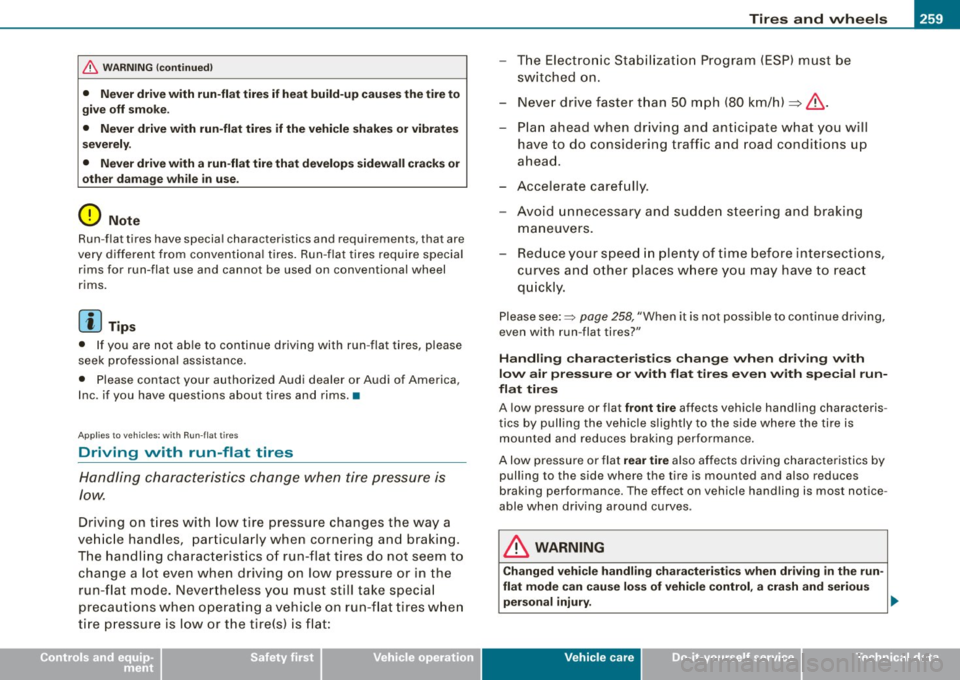
________________________________________________ T_ ir_e _s_ a_n_ d_ w_ h _e_e_ l_s __ lfll
•
& WARNING (continued)
• Never drive with run-flat tires if heat build-up causes the tire to
give off smoke .
• Never drive with run-flat tires if the vehicle shakes or vibrates
severely.
• Never drive with a run-flat tire that develops sidewall cracks or
other damage while in use .
0 Note
Run-flat tires have specia l characteristics and requirements, that are
very different from conventional tires. Run-flat tires require special
rims for run-flat use and cannot be used on conventional wheel
rims.
[ i] Tips
• I f you are not able to continue driving with run -flat tires, please
seek professional assistance.
• Please contact your authorized Audi dealer or Audi of America,
Inc . if you have questions about tires and rims. •
Applies to vehic les: with Run-flat t ires
Driving with run-flat tires
Handling characteristics change when tire pressure is
low.
Driving on tires with low tire pressure changes the way a
vehicle handles, particularly when cornering and braking.
The handling characteristics of run-flat tires do not seem to
change a lot even when driving on low pressure or in the
run-flat mode. Nevertheless you must still take special
precautions when operating a vehicle on run-flat tires when
tire pressure is low or the tire(s) is flat: The
Electronic Stabilization Program (ESP) must be
switched on.
- Never drive faster than 50 mph (80 km/h)~
&-
Plan ahead when driving and anticipate what you will
have to do considering traffic and road conditions up
ahead.
- Accelerate carefully.
- Avoid unnecessary and sudden steering and braking
maneuvers.
Reduce your speed in plenty of time before intersections,
curves and other places where you may have to react
quickly.
Please see:=> page 258, "When it is not possible to continue driving,
even with run -flat tires?"
Handling characteristics change when driving with
low air pressure or with flat tires even with special run
flat tires
A low pressure or flat front tire affects vehicle handling characteris
tics by pulling the vehicle slightly to the side where the tire is
mounted and reduces braking performance.
A low pressure or flat rear tire also affects driving characteristics by
pulling to the side where the tire is mounted and also reduces
braking performance. The effect on vehicle handling is most notice
able when driving around curves.
& WARNING
Changed vehicle handling characteristics when driving in the run
flat mode can cause loss of vehicle control, a crash and serious personal injury. .,,,
Vehicle care
I t •
Page 262 of 316
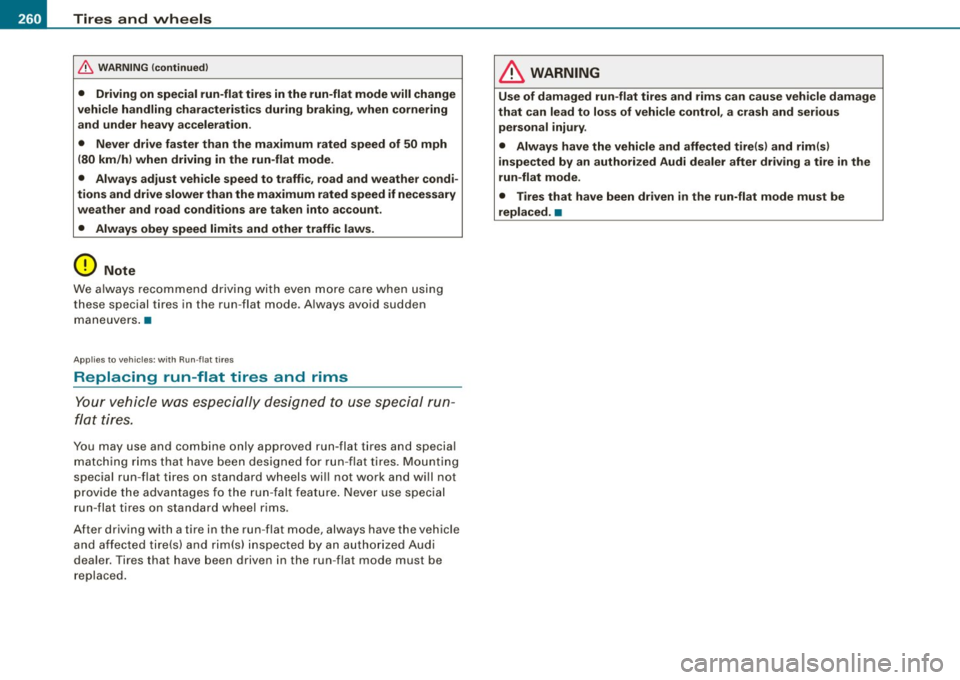
_L-_T.:..:..: ir:...:e=. s=---.: a=-:... n:..:d ::.......: w:...:....: h....:..-= e..:e :...:1-=s --------------------------------------------------
& WARNING (continued)
• Driving on special run-flat tires in the run-flat mode will change
vehicle handling characteristics during braking, when cornering
and under heavy acceleration .
• Never drive faster than the maximum rated speed of 50 mph
180 km/h) when driving in the run-flat mode.
• Always adjust vehicle speed to traffic, road and weather condi
tions and drive slower than the maximum rated speed if necessary
weather and road conditions are taken into account .
• Always obey speed limits and other traffic laws.
0 Note
We always recommend driving with even more care when using
these special tires in the run-flat mode. Always avoid sudden
maneuvers. •
Applies t o veh icles: wit h Run -f lat tires
Replacing run -flat tires and rims
Your vehicle was especially designed to use special run
flat tires.
You may use and combine only approved run-flat tires and special
matching rims that have been designed for run-flat tires. Mounting
special run-flat tires on standard wheels will not work and will not
provide the advantages fo the run-falt feature. Never use special
run-flat tires on standard wheel rims .
After driving with a tire in the run -flat mode , always have the vehicle
and affected tire(sl and rim(s) inspected by an authorized Audi
dealer. Tires that have been driven in the run -flat mode must be
replaced.
& WARNING
Use of damaged run-flat tires and rims can cause vehicle damage
that can lead to loss of vehicle control, a crash and serious
personal injury .
• Always have the vehicle and affected tire(sl and rim(sl
inspected by an authorized Audi dealer after driving a tire in the
run-flat mode.
• Tires that have been driven in the run-flat mode must be
replaced. •
Page 263 of 316
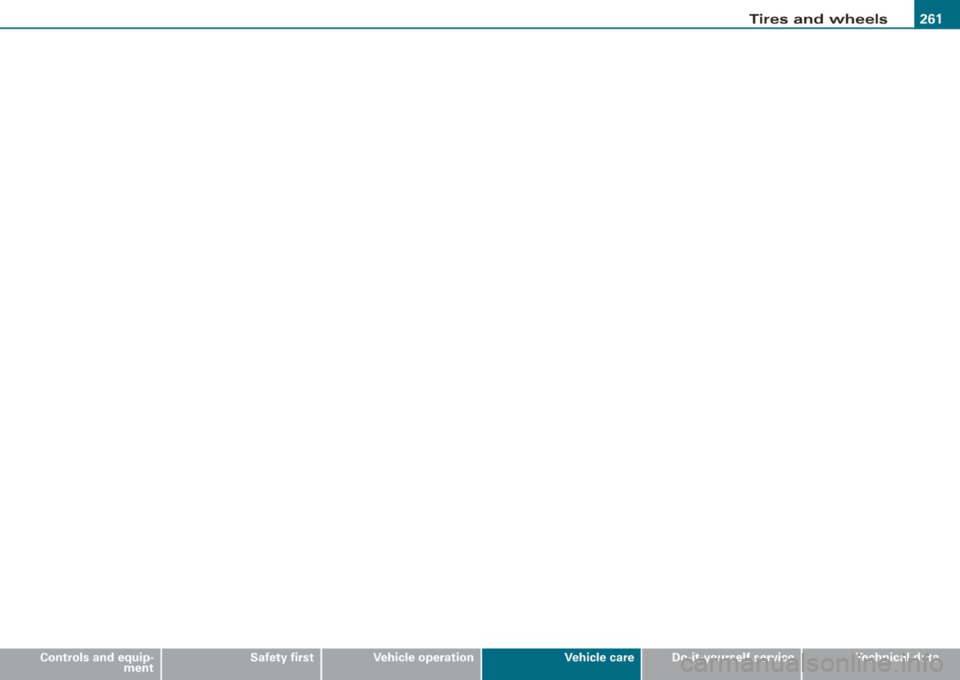
__________________________________________________ T_ ir_e_ s_ a_ n_d _ w_ h_ e_ e_l_s __ _
• Vehicle care I t •
Page 264 of 316
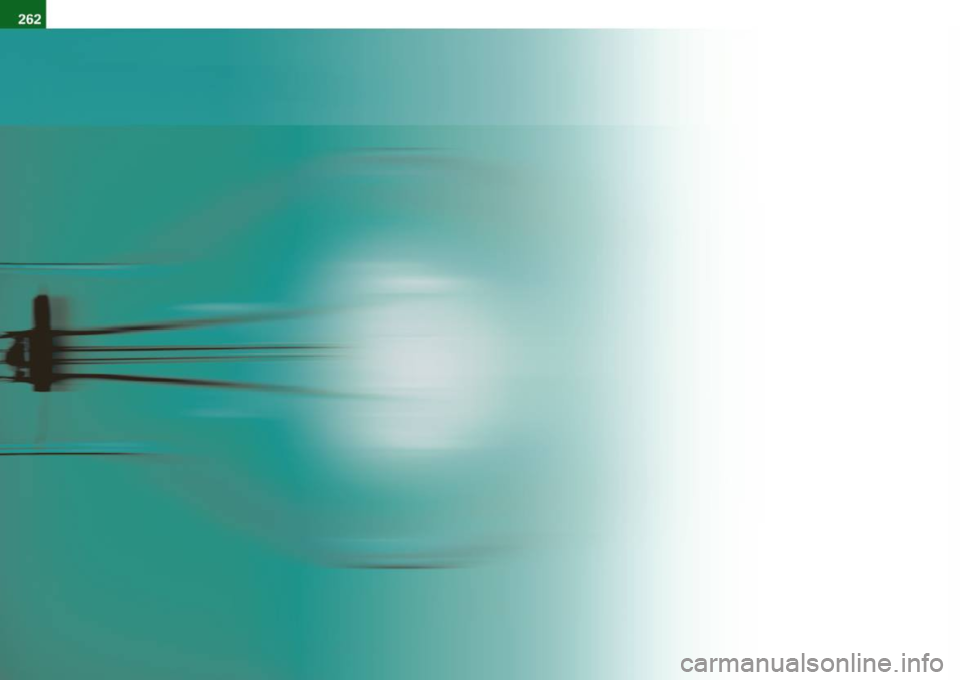
Page 265 of 316
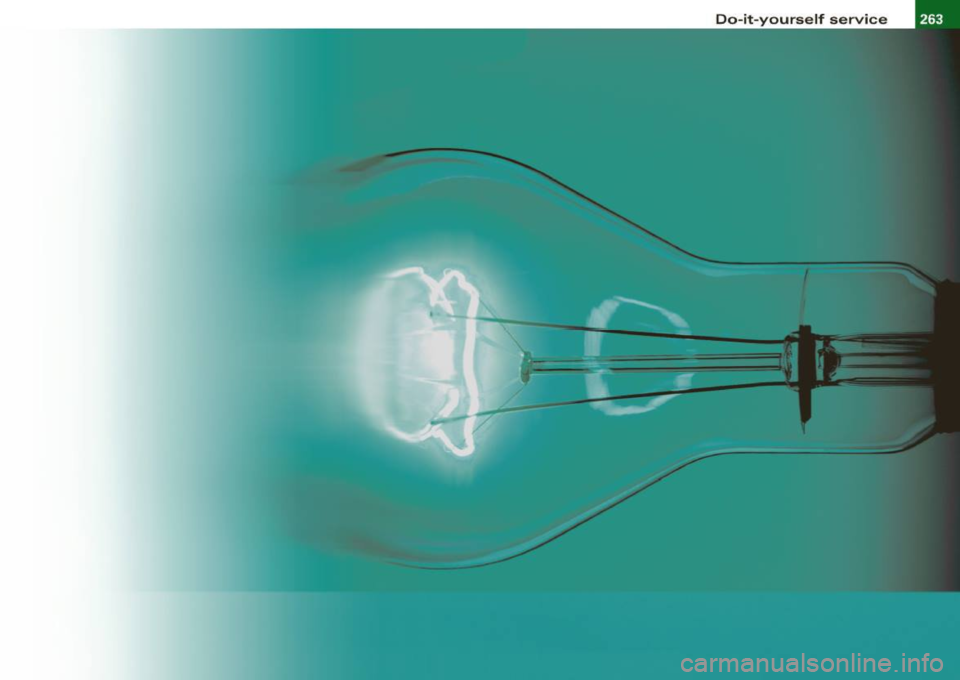
Page 266 of 316
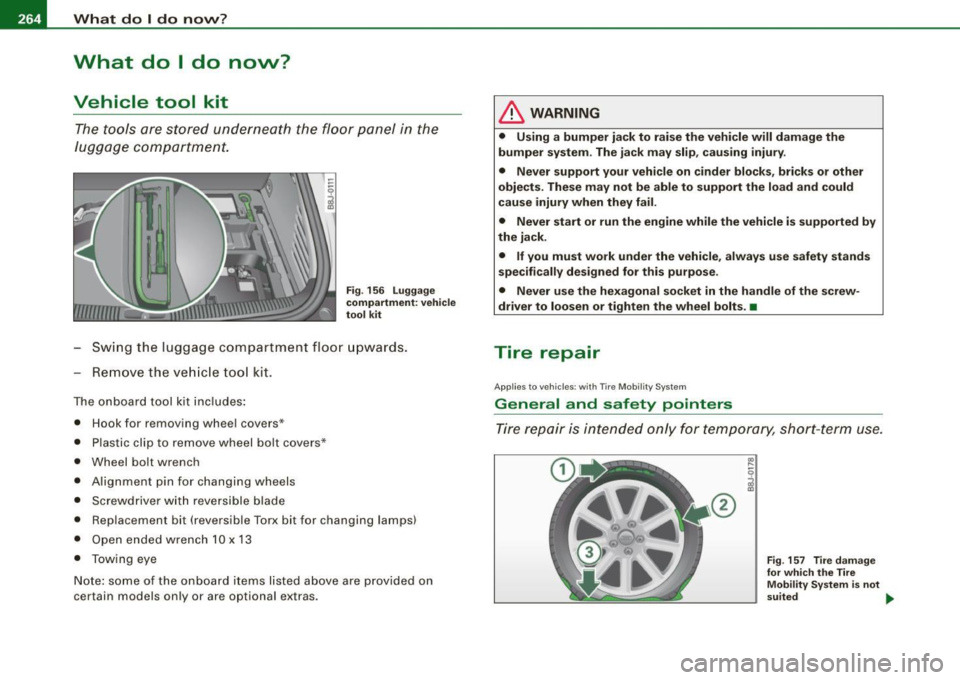
-L~W~h~a~t:_:d~o~I ~d~o~n~o~vv~? __________________________________________ _
What do I do now?
Vehicle tool kit
The tools are stored underneath the floor panel in the
luggage compartment.
-5
i
Fig. 156 Luggage
compartment: vehicle
tool kit
Swing the luggage compartment floor upwards.
- Remove the vehicle tool kit.
The onboard tool kit includes:
• Hook for removing wheel covers*
• Plastic clip to remove wheel bolt covers*
• Wheel bolt wrench
• Alignment pin for changing wheels
• Screwdriver with reversible blade
• Replacement bit (reversible Torx bit for changing lamps)
• Open ended wrench 10 x 13
• Towing eye
Note: some of the on board items listed above are provided on
certain models only or are optional extras.
& WARNING
• Using a bumper jack to raise the vehicle will damage the
bumper system. The jack may slip, causing injury .
• Never support your vehicle on cinder blocks, bricks or other
objects. These may not be able to support the load and could
cause injury when they fail.
• Never start or run the engine while the vehicle is supported by
the jack.
• If you must work under the vehicle, always use safety stands
specifically designed for this purpose .
• Never use the hexagonal socket in the handle of the screw
driver to loosen or tighten the wheel bolts . •
Tire repair
Appl ies to vehicles: with T ire Mob ili ty System
Gen eral and safety pointers
Tire repair is intended only for temporary, short-term use.
®
Fig. 157 Tire damage
for which the Tire
Mobility System is not
suited ...
Page 267 of 316
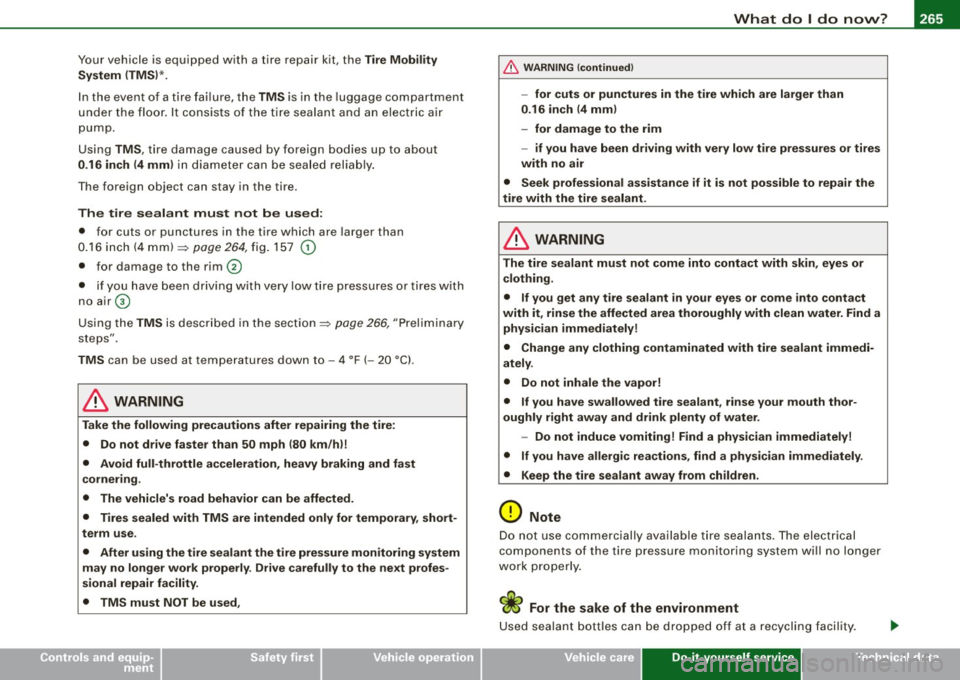
_____________________________________________ w __ h_a _t _ d_ o_ l _d _o :.....:. n,;_ o::.. w..:....:,_ ?,;_· __ Ill
•
Your vehicle is equipped with a t ire repair kit, the Tire Mobility
System (TMSl *.
In the event of a tire fai lure, the TMS is in the luggage compartment
under the floor . It consists of the tire sealant and an e lectric ai r
pump.
Using
TMS , tire damage caused by foreign bodies up to about
0.16 inch (4 mm) in d iam ete r can be sea le d reli abl y.
T he foreign object can stay i n the tire .
The tire sealant mu st not be used :
• for cuts or punctures in the tire which are larger than
0.16 inch
(4 mm )=> page 264, fig . 157 G)
• for damage to the rim@
• if you have bee n drivin g wi th very lo w tir e pr essures o r tire s w it h
no air@
Usi ng th e
TMS is de scrib ed in th e se ction=> page 2 66, "Prel imina ry
steps" .
TMS can be used at temperat ures down to -4 °F ( -20 °C).
& WARNING
Take the following precautions after repairing the tire :
• Do not drive faster than 50 mph (80 km/h)!
• Avoid full -throttle acceleration , heavy braking and fast
cornering.
• The vehicle's road behavior can be affected.
• Tires sealed with TMS are intended only for temporary , short
term use .
• After using the tire sealant the tire pressure monitoring system
may no longer work properly . Drive carefully to the next profes
sional repair facility .
• TMS must NOT be used ,
& WARNING (continued )
-for cuts or punctures in the tire which are larger than
0 .16 inch (4 mm)
- for damage to the rim
- if you have been driving with very low tire pressures or tires
with no air
• Seek professional assistance if it is not possible to repair the
tire with the tire sealant.
& WARNING
The tire sealant must not come into contact with skin , eyes or
clothing.
• If you get any tire sealant in your eyes or come into conta ct
with it , rinse the affected area thoroughly with clean water. Find a
physician immediately!
• Change any clothing contaminated with tire sealant immedi
ately.
• Do not inhale the vapor!
• If you have swallowed tire sealant , rinse your mouth thor
oughly right away and drink plenty of water .
- Do not induce vomiting! Find a physician immediately!
• If you have allergic reactions, find a physician immediately .
• Keep the tire sealant away from children.
0 Note
Do not u se co mm ercially ava ilable tire sealants . The elec trical
components of the tire pressure monitoring system wi ll no lo nger
wo rk p roperly.
~ For the sake of the environment
U sed sealant bottles ca n be dropped off at a recycling faci lity .
Do-it -yourself service
Page 268 of 316
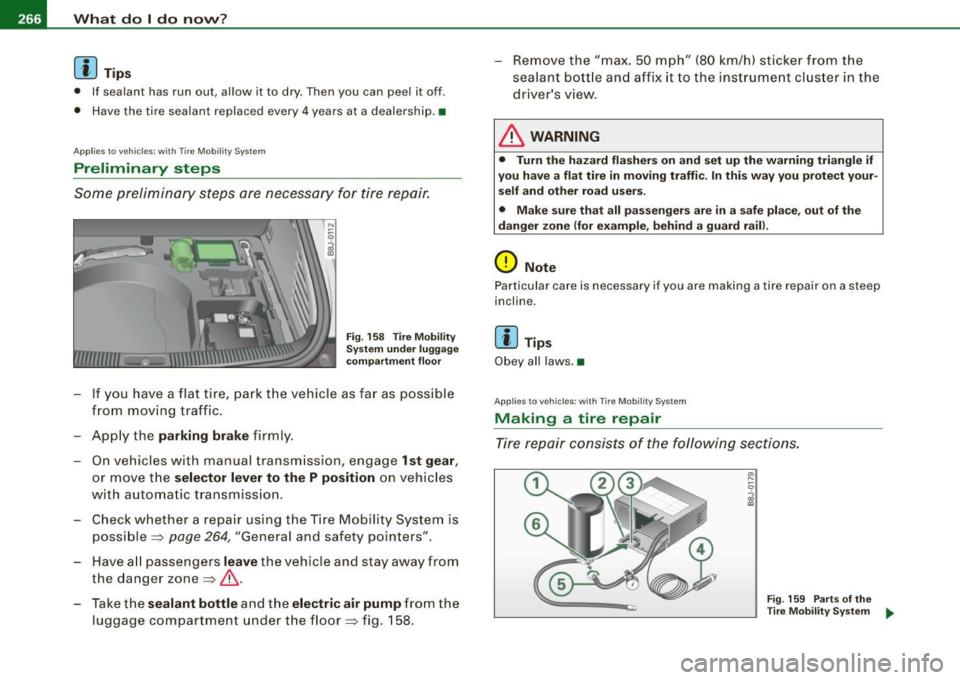
1111...__W_ h_ a _ t_d_ o_ l _d _o_ n_ o_ vv_ ? ______________________________________________ _
[ i J Tips
• If sealant has run out, allow it to dry. Then you can peel it off .
• Have the tire sealant replaced every 4 years at a d ealership. •
Applie s to ve hicles: with T ire Mob ilit y Sy stem
Preliminary steps
Some preliminary steps ore necessary for tire repair.
Fig . 158 Tire Mobility
System under luggage
compartment floor
- If you have a flat tire, park the vehicle as far as possible
from moving t raffic.
- Apply the
parking brake firmly.
- On vehicles w ith manual transmission, engage
1st gear,
or move the selector lever to the P position on vehicles
w ith automat ic transmission.
- Check whether a repair using the Tire Mob ility System is
possible ~
page 264, "General and safety po inters".
Have all passengers
leave the vehicle and stay away from
the danger zone~& .
- Take the
sealant bottle and the electric air pump from the
luggage compartment under the floor~ fig. 158. - Remove the "max. 50 mph"
(80 km/h) sticker from the
sealant bottle and affix it to the instrument cluster in the
driver's view.
& WARNING
• Turn the hazard flashers on and set up the warning triangle if
you have a flat tire in moving traffic. In this way you protect your
self and other road users.
• Make sure that all passengers are in a safe place, out of the
danger zone (for example, behind a guard raill.
(D Note
Particular care is necessary if you are making a tire repair on a steep
inc line .
[ i J Tips
Obey all laws. •
App lies to ve hicles: w ith T ire Mob ility System
Mak ing a tire repa ir
Tire repair consists of the following sections.
Fig. 159 Parts of the
Tire Mobility System ..
Page 269 of 316
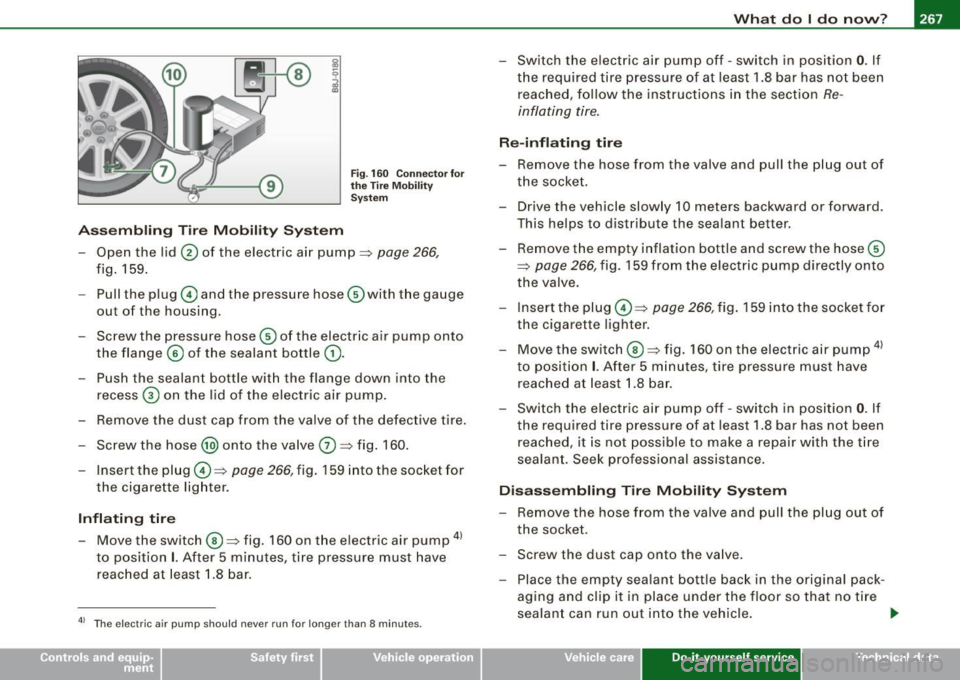
_____________________________________________ W.:..:..; h:..:.= a:.:t ..:.d=-= o:....:... I .::d :.:o :....:.. n:.:o::.. w.:...:.. ?:...___J
Assembling Tire Mobility System
Fig . 160 Connector for
the Tire Mobility System
Open the lid 0 of the electric air pump:::;, page 266,
fig. 159.
- Pull the plug © and the pressure hose G)with the gauge
out of the housing.
- Screw the pressure hose© of the electric air pump onto
the flange © of the sealant bottle
G).
-Push the sealant bottle with the flange down into the
recess
0 on the lid of the electric air pump.
- Remove the dust cap from the valve of the defective tire.
- Screw the hose@) onto the valve
0:::;, fig. 160.
- Insert the plug©:::;,
page 266, fig. 159 into the socket for
the cigarette lighter.
Inflating tire
- Move the switch®:::;, fig. 160 on the electric air pump
4
l
to position I. After 5 minutes, tire pressure must have
reached at least 1.8 bar.
41 The electric a ir pump should never run for longer than 8 minutes .
-Switch the electric air pump off -switch in position 0. If
the required tire pressure of at least 1.8 bar has not been
reached, follow the instructions in the section
Re-
inflating tire.
Re-inflating tire
- Remove the hose from the valve and pull the plug out of
the socket.
- Drive the vehicle slowly 10 meters backward or forward.
This helps to distribute the sealant better.
- Remove the empty inflation bottle and screw the hose©
:::;, page 266, fig. 159 from the electric pump directly onto
the valve.
- Insert the plug ©:::;,
page 266, fig. 159 into the socket for
the cigarette lighter.
- Move the switch®:::;, fig. 160 on the electric air pump
4
l
to position I. After 5 minutes, tire pressure must have
reached at least 1.8 bar.
- Switch the electric air pump off -switch in position
0. If
the required tire pressure of at least 1.8 bar has not been
reached, it is not possible to make a repair with the tire
sealant. Seek professional assistance.
Disassembling Tire Mobility System
- Remove the hose from the valve and pull the plug out of
the socket.
- Screw the dust cap onto the valve.
- Place the empty sealant bottle back in the original pack-
aging and clip it in place under the floor so that no tire
sealant can run out into the vehicle. .,
Vehicle care Do-it-yourself service irechnical data
Page 270 of 316
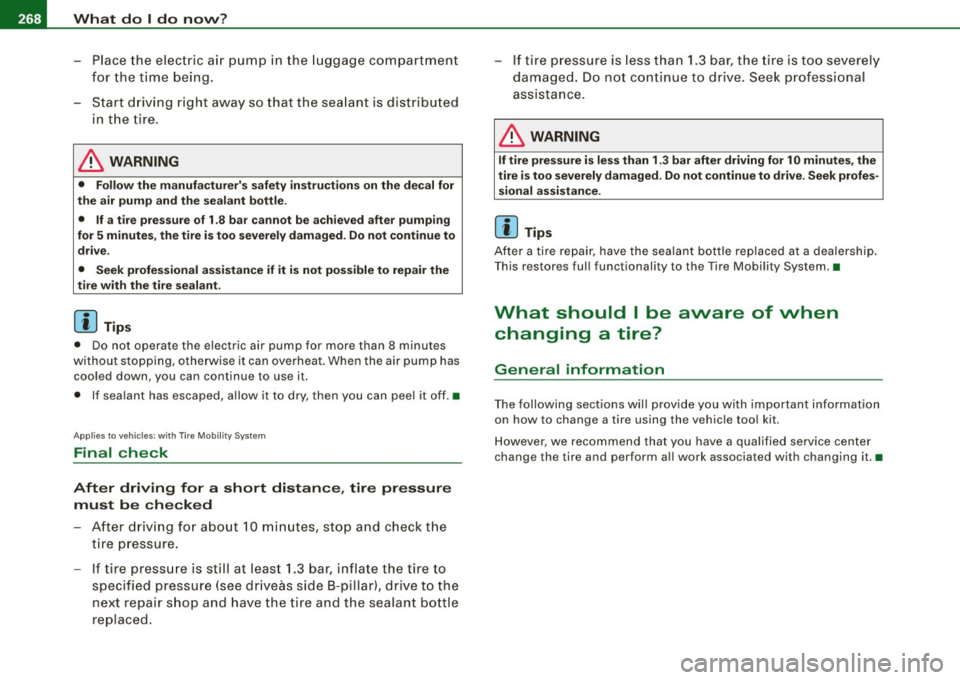
11111.___W_ h_ a _ t_d_ o_ l _d _o_ n_ o_ w_ ? ______________________________________________ _
-Place the electric air pump in the luggage compartment
for the time being.
- Start driving right away so that the sealant is dist ributed
in the tire.
& WARNING
• Follow the manufacturer's safety instructions on the decal for
the air pump and the sealant bottle.
• If a tire pressure of 1.8 bar cannot be achieved after pumping
for 5 minutes, the tire is too severely damaged. Do not continue to
drive.
• Seek professional assistance if it is not possible to repair the
tire with the tire sealant.
[ i] Tips
• Do not operate the electric air pump for more than 8 minutes
without stopping, otherwise it can overheat. When the air pump has
cooled down, you can continue to use it.
• If sealant has escaped, allow it to dry, then you can peel it off. •
Applies to veh icles: with Tire Mob ili ty Sys tem
Final check
After driving for a short distance, tire pressure
must be checked
- After driving for about 10 minutes, stop and check the
tire pressure.
- If tire pressure is still at least 1.3 bar, inflate the tire to
specified pressure (see driveas side B-pillarl, drive to the
next repair shop and have the tire and the sealant bottle
replaced. -
If tire pressure is less than 1.3 bar, the tire is too severely
damaged. Do not continue to drive. Seek professional
assistance.
& WARNING
If tire pressure is less than 1.3 bar after driving for 10 minutes, the
tire is too severely damaged. Do not continue to drive. Seek profes
sional assistance.
[ i] Tips
After a tire repair, have the sealant bottle replaced at a dealership.
This restores full functionality to the Tire Mobility System. •
What should I be aware of when
changing a tire?
General information
The following sections will provide you with important information
on how to change a tire using the vehicle tool kit.
However, we recommend that you have a qualified service center
change the tire and perform all work associated with changing it. •